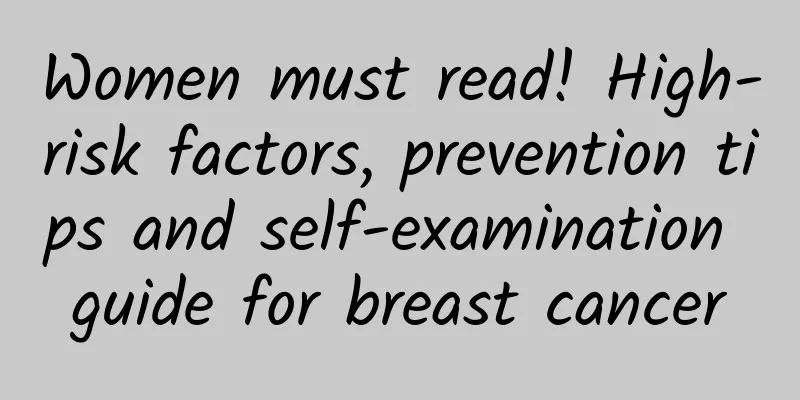Women must read! High-risk factors, prevention tips and self-examination guide for breast cancer

|
Author: Sun Qiang, Chief Physician, Peking Union Medical College Hospital Reviewer: Bai Wenpei, Chief Physician, Beijing Century Altar Hospital, Capital Medical University Breast cancer, as one of the most common malignant tumors in women, has an increasing incidence rate worldwide, posing a serious threat to women's lives and health. However, by gaining a deeper understanding of the risk factors, typical symptoms, diagnosis methods and preventive measures of breast cancer, we can effectively reduce its risks and improve treatment outcomes. 1. Predisposing factors of breast cancer The onset of breast cancer is a complex process involving the interaction of multiple factors, which can be roughly divided into two categories: uncontrollable factors and controllable factors. 1. Uncontrollable factors mainly include genetics and female physiological characteristics. Genetic factors play an important role in the development of breast cancer. About 20% of breast cancer cases are related to genetics. Those with a family history of breast cancer, especially those with a direct relative who is ill, have a significantly increased risk of developing the disease. In addition, women's physiological characteristics such as early menarche, late menopause, and short menstrual cycles are also risk factors that cannot be ignored. These physiological characteristics may cause the estrogen level in the body to remain at a high level for a long time, thereby increasing the risk of breast cancer. Figure 1 Original copyright image, no permission to reprint 2. Controllable factors are more related to personal lifestyle and environmental choices. Childbirth and breastfeeding are key factors. Women who have not given birth or are not breastfeeding have a relatively high risk of breast cancer. An active lifestyle, such as physical exercise, maintaining a reasonable weight, a balanced diet, and limiting alcohol intake, can effectively reduce the risk of breast cancer. In addition, environmental factors such as urban pollution and work pressure may also affect the incidence of breast cancer, and the use of perimenopausal or postmenopausal hormone replacement therapy is also believed to increase the risk of breast cancer. 2. Early Detection and Diagnosis Early detection and diagnosis of breast cancer are of vital importance to improving treatment outcomes and prolonging patient survival. The most typical symptom of breast cancer is a painless mass, and other symptoms include nipple discharge (especially bloody discharge), nipple inversion, skin changes, etc. However, these symptoms do not occur in all breast cancer patients, and some symptoms may be similar to other breast diseases, so self-diagnosis based on symptoms alone is not reliable. Figure 2 Original copyright image, no permission to reprint Thanks to the widespread popularity of breast cancer screening in China, more and more cases are being discovered at an early stage. Most early breast cancers have not yet formed large masses, and most are intangible breast lesions, which are mostly discovered through physical examinations with breast ultrasound or breast mammography. Chinese women have denser glands than foreign women, and are more suitable for ultrasound-based screening. In order to detect and diagnose breast cancer early, it is recommended that women over 35 years old undergo a breast ultrasound examination once a year. For women with a family history of breast cancer, this age can be advanced to 20-25 years old. The diagnosis of breast cancer requires a series of clinical examinations and auxiliary examinations. The doctor will first perform a preliminary screening through breast palpation, and then may arrange imaging examinations such as ultrasound examination and mammography to further evaluate the nature of the mass. When these examinations indicate the possibility of malignancy, the final diagnosis needs to be completed through histopathological examination. Although this process is cumbersome, it is the cornerstone of ensuring diagnostic accuracy and formulating personalized treatment plans. 3. Dispelling Misunderstandings: Facing Breast Cancer Scientifically In the process of breast cancer prevention and treatment, the public's misunderstanding of breast cancer often becomes one of the important reasons for delayed diagnosis and treatment. Among them, the misunderstanding about breast lumps is particularly prominent. Many women think that there is no problem as long as the breast lump is not painful, thus ignoring its potential danger. In fact, painless lumps are one of the most common symptoms of breast cancer. Therefore, once a lump is found in the breast, whether there is pain or other accompanying symptoms, you should go to the hospital immediately to avoid missing the best time for treatment. In addition, the question of whether breast augmentation surgery can induce breast cancer has also attracted much attention. Although the relationship between breast augmentation surgery and breast cancer is complex and the specific degree of the relationship depends on the breast augmentation method and technology, existing studies have shown that the use of formal and safe breast augmentation methods and technologies does not increase the risk of breast cancer. However, in order to protect their own health and safety, women should carefully choose medical institutions and doctors when choosing breast augmentation surgery, and fully understand the risks and precautions of the surgery. 4. Breast cancer prevention and self-examination To prevent breast cancer, it is important to adjust your lifestyle. Maintaining healthy living habits, such as regular exercise, a balanced diet, weight control, and limiting alcohol intake, are effective ways to reduce the risk of breast cancer. For healthy people, at least 4 hours of physical exercise per week can significantly reduce the risk of breast cancer. Controlling weight and avoiding excessive obesity are especially important for women over 60 years old. Overweight or obesity after menopause can increase the risk of breast cancer. Adjusting the diet structure, reducing the intake of high-fat, high-calorie foods, and increasing the intake of vegetables, fruits, and whole grains are also beneficial to breast health. In addition, avoiding excessive drinking is also an integral part of preventing breast cancer. When it comes to breast cancer, early detection, early diagnosis, and early treatment are key. Self-examination and regular professional screening can effectively improve the early detection rate of breast cancer. Women should master the skills of self-examination, regularly observe the appearance of their breasts, touch their breasts, and pay attention to any subtle changes. At the same time, women over 35 should undergo breast cancer screening every year. For women with a lower risk of breast cancer, if no abnormalities are found in self-examination, the screening interval can be appropriately extended. Although the incidence of breast cancer in men is low, they should also pay attention to breast health and seek medical attention immediately if any abnormalities are found. |
>>: Do you know the eight reasons for frequent headaches?
Recommend
The benefits of eating more beef for women
Beef is rich in nutrients, with a high protein co...
Causes of dark red non-menstrual bleeding
If a female friend experiences dark red bleeding ...
Can uterine fibroids be treated with abortion?
Nowadays, the probability of women suffering from...
Woman feels dizzy, nauseous, vomiting, and tinnitus
If a woman experiences symptoms such as headache,...
Can chestnuts be eaten with shrimps? What can chestnuts be used to make porridge?
Chestnuts have the function of nourishing yin and...
Can I abort my pregnancy at 3 months? What is the best time to abort?
Many pregnant mothers are told that there are pro...
The incidence of prostate cancer is increasing year by year. Men over 50 must pay attention to this examination!
Prostate cancer is the most common malignant tumo...
Light sleep, deep sleep and dreaming, these are the things you need to know
- Can't sleep - what to do Deep sleep plays a...
How many people need to be vaccinated to eliminate the new coronavirus?
This issue of popular science comics mainly intro...
What are the main methods for preventing breast cancer?
The prevention of breast tumors is an issue that ...
What is the black color in the vaginal discharge?
Normal women will have leucorrhea after puberty. ...
How to maintain a woman's uterus
There is a close connection between women's p...
Secrets to maintaining a healthy woman's private parts
What is the purpose of pubic hair? There are hair...
Is it normal for fur to have an odor? How to remove the odor of newly bought fur?
Fur is very common in our daily life, especially ...
Why is my period suddenly so light this month?
Generally speaking, women's menstruation is v...









